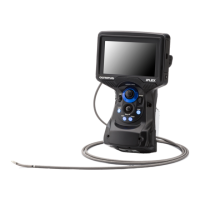Chapter 4 Operation
95
EVIS LUCERA GIF/CF/PCF TYPE 260 Series OPERATION MANUAL
Flexibility adjustment (for endoscopes with flexibility
adjustment only)
• Do not change the insertion section’s flexibility abruptly.
Otherwise, patient pain, injury, bleeding, and/or perforation
can result.
• If the endoscopic image moves suddenly or is lost while you
are changing the insertion section’s flexibility, stop changing
the flexibility and restore the optimum field of view. Moving
the flexibility adjustment ring without a clear endoscopic
image may cause patient pain, injury, bleeding, and/or
perforation.
• If the patient complains of pain while you are changing the
insertion section’s flexibility, stop changing the flexibility and
ensure the safety of the patient.
• If the rigidity of the insertion section has to be increased
during an examination, confirm that there are no loops or
excessive bends in the insertion section (if necessary, use
fluoroscopy, or for CF-Q260DL/I, CF-H260DL/I, use an
endoscope position detecting unit) before increasing its
rigidity. If the force required to turn the flexibility adjustment
ring is greater during the procedure than it was when
inspecting the endoscope, it may mean that the insertion
section is excessively bent inside the patient. In this case,
straighten the insertion section as much as possible before
attempting to increase the rigidity. Failure to do so may cause
patient pain, injury, bleeding, and/or perforation.

